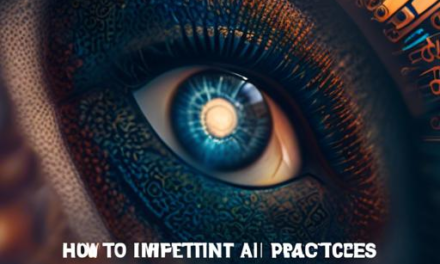In the dawn of our tech-driven era, where artificial intelligence (AI) entwines with the fabric of our daily existence, the call for ethical AI development echoes more urgently than ever before. Imagine a world where machines not only think for us but also uphold our ideals, navigate moral crossroads, and make decisions rooted in integrity. This isn’t a utopian dream—it’s a vision within our grasp. With unwavering commitment and thoughtful guidance, we forge pathways to foster ethical AI development, ensuring that these digital minds reflect the very best of our human values. In this article, we embark on a journey to uncover the principles, practices, and collaborative efforts necessary to nurture an AI landscape that is safe, fair, and beneficial for all. Welcome to a guide where technology and ethics unite, creating a future as intelligent as it is just.
Table of Contents
- Building a Strong Ethical Framework for AI Innovation
- Empowering Diverse Teams to Drive Ethical AI Solutions
- Transparency and Accountability: The Pillars of Ethical AI
- Harnessing Bias-Free Data for Responsible AI Development
- Implementing Robust Privacy Measures in AI Systems
- Creating a Culture of Continuous Ethical Education in AI
- Engaging Stakeholders in Inclusive AI Governance
- Measuring and Monitoring the Ethical Impact of AI Deployment
- In Retrospect
Building a Strong Ethical Framework for AI Innovation
To truly harness the power of artificial intelligence while ensuring its ethical integrity, it’s pivotal to establish a robust ethical framework. This ensures that AI innovations not only advance technology but also uplift humanity.
Key Principles of Ethical AI
Embracing core principles is fundamental to ethical AI development. Organizations should prioritize:
- Transparency: Clearly explaining how AI systems function and make decisions.
- Fairness: Preventing biases that could discriminate against people based on race, gender, or other factors.
- Accountability: Ensuring that there is a clear line of responsibility for the actions and decisions made by AI systems.
- Privacy: Protecting personal data and ensuring user consent in data handling.
Building Multidisciplinary Teams
To build ethical AI, it’s essential to incorporate diverse perspectives. This involves:
- Inviting **ethicists, sociologists**, and **legal experts** to participate in AI development discussions.
- Fostering collaboration between **technical engineers** and **humanities scholars**.
- Encouraging **continuous learning** about ethical standards and societal impacts among team members.
Ethical AI Guidelines and Compliance
Adopting comprehensive guidelines can aid in steering AI projects in the right direction. Here is a basic guideline chart to get started:
| Aspect | Guideline |
|---|---|
| Data Usage | Ensure data is anonymized and user consent is obtained. |
| Bias Mitigation | Regularly check algorithms for bias and adjust as necessary. |
| Transparency | Document AI processes and make them accessible to users. |
| Security | Implement robust security measures to protect data integrity. |
| User Impact | Evaluate the societal impact of AI applications continually. |
Integrating these components into AI development processes will pave the way for responsible and ethical usage of AI technologies. By adhering to these principles and guidelines, organizations can ensure they are creating AI systems that are not only intelligent but also fair, transparent, and respectful of human values.
Empowering Diverse Teams to Drive Ethical AI Solutions
Encouraging diversity within AI development teams is crucial for fostering ethical solutions. Diverse perspectives help identify biases that might otherwise go unnoticed and ensure a more inclusive approach to problem-solving. Here’s how to build and support such teams effectively:
- Inclusive Hiring Practices: Strive to build a team with varied backgrounds in terms of gender, ethnicity, socioeconomic status, and educational paths. This can be achieved through blind recruitment processes, tapping into diverse networks, and actively fighting unconscious bias in hiring decisions.
- Cultural Competency Training: Equip your team with the skills to understand, respect, and leverage cultural differences. This involves regular workshops and training sessions aimed at improving communication and collaboration across different cultural contexts.
| Strategy | Implementation |
|---|---|
| Mentorship Programs | Pair junior employees with seasoned professionals to foster growth and knowledge exchange. |
| Flexible Work Environment | Accommodate different working styles and needs, such as remote work options and flexible hours. |
Empowering diverse teams doesn’t stop at diversity in hiring. It also involves creating a work environment where everyone feels valued and heard. **Promote an open-door policy**, ensuring team members have a safe space to share their thoughts and concerns. Regular check-ins can help reinforce this culture of inclusivity.
Moreover, encourage continuous learning and adaptation. Technology, especially AI, evolves rapidly. To stay ahead and uphold ethical standards, provide your team with opportunities to pursue further education and innovations in AI through workshops, courses, and conferences. Embrace a mindset that learning is never complete, and ethical considerations must evolve alongside technological advancements.
Transparency and Accountability: The Pillars of Ethical AI
In the realm of Artificial Intelligence, transparency and accountability form the ethical foundation upon which trust is built. Ensuring that the algorithms and models are open to scrutiny means that their decisions can be understood, questioned, and improved. This is crucial in fostering public trust and enabling collaboration among stakeholders.
Here are some key strategies to enhance these core principles in AI development:
- Open Datasets and Models: Sharing datasets and models openly promotes inspection and replication, which bolsters trust. By making these available to the public, we can ensure that the AI systems are trained on unbiased, representative data.
- Clear Documentation: Detailed documentation of AI systems, including their decision-making processes and underlying data, allows for better understanding and critique. This should cover everything from data sources to algorithmic choices and potential biases.
- Diverse Team Involvement: A diverse development team brings multiple perspectives, reducing blind spots and raising relevant ethical concerns early in the process.
Implementing these approaches can be facilitated through structured methodologies and best practices. The following table outlines some of the recommended steps:
| Methodology | Best Practices |
|---|---|
| Algorithmic Transparency | Regular audits and white-box testing |
| Responsibility Assignment | Clear roles for development and maintenance |
| Public Reporting | Annual reports on AI ethics and outcomes |
Transparency and accountability not only align with ethical standards but also drive innovation. When developers know their work will be reviewed, they are incentivized to adhere to the highest standards. Moreover, accountability ensures that any misuse or unintended consequences are swiftly addressed, maintaining the integrity of AI technologies.
Harnessing Bias-Free Data for Responsible AI Development
In the quest to create ethical AI systems, **bias-free data** emerges as an invaluable asset. It’s essential to rely on datasets that are not tainted by societal prejudices, ensuring equal treatment of all users. This action contributes not only to the fairness and accuracy of AI models but also to their broader acceptance and trust by the public.
- Identifying Bias: Utilize advanced tools to detect and eliminate bias in datasets.
- Diverse Perspectives: Include data from diverse sources, considering varied demographics and contexts.
- Regular Audits: Conduct periodic reviews and audits of your data sources to maintain integrity.
One way to achieve a bias-free data environment is by employing a systematic approach to data collection and preprocessing. For example, applying techniques that anonymize data effectively can prevent any undue influence of irrelevant attributes on the AI models.
| Action | Purpose | Outcome |
|---|---|---|
| Data Anonymization | Remove personal identifiers | Prevention of identity-based biases |
| Diverse Data Inclusion | Incorporate varied input sources | Balanced representation in AI models |
| Regular Monitoring | Continuous oversight | Maintained accuracy and fairness |
Furthermore, fostering a culture of interdisciplinary collaboration is vital. Bringing together experts in ethics, social sciences, and technology can uncover hidden biases and lead to more robust mitigation strategies.
- Ethical Committees: Establish ethical oversight bodies within your organization.
- Transparent Practices: Promote transparency in data collection and preprocessing methods.
- Community Feedback: Engage with user communities to gather insights and feedback.
By harnessing bias-free data, we not only pave the way for responsible AI development but also contribute to a future where technology empowers and unites rather than divides. Let’s commit to these practices and principles to build an ethical AI landscape that truly benefits all.
Implementing Robust Privacy Measures in AI Systems
Privacy in AI systems isn’t just a technical requirement; it’s a moral obligation. Implementing **robust privacy measures** serves as a cornerstone in fostering ethical AI development. These measures help maintain trust, safeguard user data, and ensure compliance with evolving regulations. Below are some strategies to weave privacy into the very fabric of AI systems effectively.
- Data Anonymization: Turning sensitive data into anonymous data helps in protecting personal information. Techniques like data masking, generalization, and synthetic data generation ensure that the data remains useful while safeguarding user identities.
- Encryption Protocols: Robust encryption mechanisms prevent unauthorized access and leaks. Implementing both at-rest and in-transit encryption ensures data security throughout its lifecycle.
- Access Controls: Fine-grained access control mechanisms ensure that only authorized personnel can access sensitive information. Role-based access control (RBAC) and attribute-based access control (ABAC) are effective models to consider.
Moreover, it’s essential to conduct regular privacy impact assessments (PIAs) to evaluate the potential risks and mitigation strategies related to data privacy. PIAs can help identify vulnerabilities and align AI practices with privacy laws and guidelines, such as the GDPR and CCPA.
| Strategy | Benefit |
|---|---|
| Data Anonymization | Protects user identity |
| Encryption Protocols | Secures data |
| Access Controls | Limits unauthorized access |
| Privacy Impact Assessments | Evaluates data risk |
Incorporating these privacy measures not only ensures regulatory compliance but also builds a trustworthy relationship with users. Transparent communication about the privacy measures in place, such as clear privacy policies and data handling practices, further strengthens user confidence.
Creating a Culture of Continuous Ethical Education in AI
To nurture a thriving environment for ethical AI development, instilling a culture of **continuous ethical education** is imperative. This begins with embedding ethical considerations into the very fabric of AI research, development, and deployment processes. Schools, universities, and organizations should incorporate structured ethics education into their curricula and training programs.
**Key Practices**:
- Interactive Workshops: Regular workshops that involve real-world ethical dilemmas can encourage developers to think critically about the implications of their work, beyond just the technical aspects.
- Mentorship Programs: Pairing less experienced individuals with seasoned professionals who prioritize ethical practices can provide invaluable learning opportunities.
- Ethics Committees: Establishing dedicated committees to oversee AI projects ensures continuous ethical oversight and encourages a proactive approach to addressing ethical concerns.
**The Role of Collaboration**:
Encouraging partnerships with diverse stakeholders helps to maintain a holistic perspective on ethics in AI. This includes not just developers and researchers, but also ethicists, sociologists, and representatives from various social sectors.
| Stakeholder | Contribution |
|---|---|
| Developers | Technical execution |
| Ethicists | Ethical framework |
| Sociologists | Societal impact |
| Community Reps | Inclusivity and diversity |
**Leveraging Technology**:
- Ethics Management Software: Tools that track compliance and highlight potential ethical risks can aid organizations in maintaining responsible AI practices.
- Continuous Learning Platforms: Online courses, webinars, and certification programs focused on AI ethics can help professionals stay updated on best practices and emerging challenges.
Building a culture of continuous ethical education isn’t a one-time effort but an ongoing journey. It demands commitment and collaboration from all parties involved, fostering an environment where ethical considerations are as paramount as technical achievements.
Engaging Stakeholders in Inclusive AI Governance
To cultivate a truly ethical AI development environment, an inclusive approach to governance is imperative. This begins with actively engaging diverse stakeholders, ensuring that every voice is heard and valued in the process. The perspectives of underrepresented communities, industry leaders, regulatory bodies, and users themselves are crucial for the creation of AI systems that are not only innovative but also equitable and just.
- Multidisciplinary Teams: Incorporate experts from diverse fields such as ethics, sociology, and law alongside technologists to offer balanced viewpoints and address complex ethical concerns.
- Public Consultations: Arrange community forums and open consultation periods to gather feedback from ordinary citizens about their concerns and hopes for AI technologies.
- Transparent Communication: Develop clear channels for regular updates on AI projects, ensuring transparency at every stage of the development lifecycle.
Effective stakeholder engagement can also be facilitated through partnerships between sectors. Collaborative efforts between academic institutions, private companies, and public sector organizations foster a comprehensive understanding of both opportunities and risks. Establishing working groups or councils dedicated to ethical AI can provide sustained guidance and ensure that governance structures evolve with technological advancements.
| Stakeholder Group | Role in AI Governance |
|---|---|
| Academic Researchers | Produce foundational research and ethical guidelines |
| Private Sector | Integrate ethical principles into product development |
| Regulatory Bodies | Create and enforce compliance standards |
| Public Citizens | Provide invaluable personal insights and feedback |
An inclusive approach also includes a commitment to lifelong learning and adaptation. Holding regular training sessions on ethics for developers and keeping abreast with latest ethical dilemmas and solutions in AI research ensures that the team is always prepared to tackle new challenges. This culture of ongoing education supports a robust governance framework capable of fostering ethical AI development.
Measuring and Monitoring the Ethical Impact of AI Deployment
The integration of artificial intelligence (AI) into various sectors demands a rigorous approach to measuring and monitoring its ethical impact. **Transparent criteria** and **clear metrics** are crucial to ensure that AI systems are developed and deployed responsibly. This includes establishing key performance indicators (KPIs) related to ethical considerations, such as fairness, accountability, and transparency.
One effective method to monitor the ethical impact is to employ continuous auditing. This involves conducting regular assessments to verify that AI systems comply with established ethical standards. Key areas to audit include the following:
- **Bias and Fairness**: Ensuring that AI algorithms do not disproportionately affect any particular group.
- **Privacy**: Protecting users’ personal data and maintaining confidentiality.
- **Transparency**: Keeping AI decision-making processes open and understandable to end-users.
| Ethical KPI | Description | Example |
|---|---|---|
| Bias and Fairness | Measure of algorithm’s impartiality and nondiscrimination. | Comparing error rates across different demographic groups. |
| Privacy | Evaluation of data protection and user consent procedures. | Regular privacy audits and user feedback surveys. |
| Transparency | Level of clarity in AI’s decision-making process. | Documentation and explanatory interfaces for AI models. |
Organizations should also establish **feedback mechanisms** that allow users to report ethical concerns. This can be through dedicated channels such as suggestion boxes, online forms, or direct contact with an ethics committee. Addressing these concerns promptly demonstrates a commitment to ethical AI development and fosters trust among users.
Incorporating these strategies will aid in the careful oversight of AI systems, ensuring they align with ethical standards and contribute positively to society. Regular training and awareness programs for all stakeholders involved in the AI lifecycle can further support the continuous ethical development of AI technologies.
In Retrospect
As we embark on the journey of developing ethical AI, let us remember that the power lies in our hands to shape a future where technology serves humanity with empathy and morality. Let’s continue to prioritize transparency, accountability, and inclusivity in all aspects of AI development. Together, we can pave the way for a world where artificial intelligence truly enhances our lives in a responsible and ethical manner. So, let’s champion ethical AI development and create a better tomorrow for all. The future is ours to shape, let’s make it a bright and ethical one.































